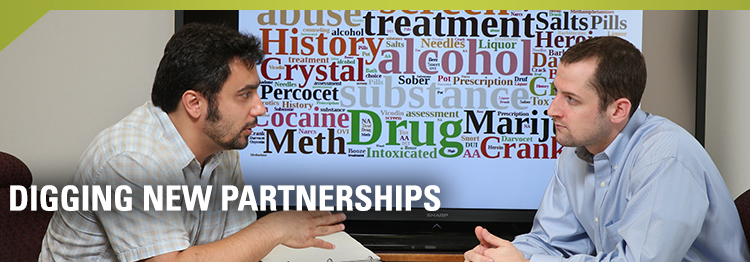Digging new partnerships
Text-mining project impacts child abuse cases

By Julie Carle
Two BGSU students have a hand in a text-mining project that could impact the outcome of child abuse cases in Ohio.
In partnership with several county offices of the Ohio Job and Family Services’ (OJFS) agency, Quality Systems graduate students Mike Adams and Armen Ilikchyan are analyzing child welfare data to reduce failure rates in placing children in at-risk environments. They are working with Wood, Auglaize, Knox, Licking and Sandusky counties on a model that eventually could be used statewide.
The project, “Quality Methods Applied To Child Welfare System,” was sponsored by Wood County Department of Job and Family Services, in concert with the other four counties. The one-year project was funded for $50,733, which included over $13,000 supplied through BGSU’s Graduate College to help support the graduate students. Dr. John Sinn, professor of quality systems and chair in the Department of Engineering Technology, has been the primary contact and investigator at BGSU for the project.
Using data mining, Adams, a master’s degree student, and Ilikchyan, a doctoral fellow, are studying recidivism in child maltreatment cases that involve substance abuse. Their work is designed to help the agencies to better identify instances of substance abuse in these situations.
The importance of this project comes on the heels of three untimely child abuse cases in Wood County in 2012, where two children died and another child suffered a fractured skull all within two months of one another.
David Wigent, director of the OJFS Wood County office – the lead office for this project – said, “Traditionally, information related to substance abuse in cases is noted by social workers in their notes, and not easily accessible for reporting or tracking.” Adams and Ilikchyan are figuring out how to extract the information by converting the documents into a structured format and looking at the frequency of words in the documents.
The work that is being done “will help us in targeting resources and gaining a better understanding of what factors lead to failure in child abuse cases. It helps us target areas that are most troublesome,” Wigent explained.
“We have broken new ground at least in child welfare,” Wigent continued. “Text mining is unheard of in the state system, but if we could identify some funding, then there would be no obstacles to implement this system statewide. This is particularly significant when considering that there is an enormous amount of information, mostly text in this case, which has been provided by social workers and caseworkers engaged in child welfare.
“I’m confident we could show a return on investment,” he said. For every dollar invested, the outcomes of child abuse cases could be improved and the length of time the cases go on could be reduced, he added.
This effort was an offshoot of work Adams did during an undergraduate co-op while at BGSU. Using quality control and statistical analysis, his task was to ensure that the agencies’ newly established virtual call center for seven counties was more efficient and not hindering the quality of services. The call center partnership, called Collabor8, earned the agencies national recognition for efficiency and service.
‘That successful work led to discussions of other topics, such as child welfare,” Wigent said. Instead of a co-op, the next phase of the project was a Student-Based Applied Research (SBAR) project, which is more of a consulting project, overseen by a BGSU faculty member.
In this case, Sinn is the faculty mentor for the project. The success of this and other SBAR projects is because there is a major investment by everyone – the student, the faculty member and the organization all have a vested interest, he said. With an SBAR, the outside agency contracts with BGSU to help with a project, and BGSU matches the talents of a student with the needs.
“With this project Mike had a unique talent with the statistics and enough experience with the agencies that it proved to be a good fit,” Sinn said. Much of this work, leading to the current project, has involved how to convert quality systems from other disciplines, such as manufacturing, into a social services environment.
“We moved from the co-op into the SBAR for continuity with Mike,” Wigent said.
Ilikchyan got involved as an adjunct instructor for one of Adams’ undergraduate classes.
A group of Ilikchyan’s students was used to start tracking the status of the project. A discussion about the project resulted in the teacher’s involvement. He was intrigued with the use of mathematical algorithms to analyze and manipulate the textual data. His fascination with data science ignited his interest in the project. He also brought to the project knowledge about children’s services; his mother works in child welfare in Russia.
“I was extremely interested in data versus the social implications,” Ilikchyan said. “This offered a huge opportunity to me to show my capabilities in this area.”
Partnership Beginnings
Sinn likes to tell of the humble beginnings of this partnership when he was looking for opportunities to work with businesses and organizations that could benefit from the quality systems and engineering technology expertise of BGSU students and faculty. Then Wood County Commissioner Tim Brown, who is now a state representative, invited Sinn to a county meeting to explain the services.
Wigent happened to be at the meeting and was intrigued with the possibilities. He worked with Sinn on some possible projects and initiated first the co-op followed by the SBAR. Now he has become an advocate for the services, and is hopeful OJFS will see the long-term benefit of working with BGSU to extend the project.
“If we can apply these processes across the state, we can directly impact more lives,” he said.
Updated: 12/02/2017 12:55AM
